Your bedroom is your sanctuary—a retreat that revives and refreshes you. By adding a few plants, you can quickly turn your bedroom into a lush oasis. In fact, green plants are an easy way to redecorate and elevate the look of any room in your home.
Plants are not only beautiful, but they also improve your mood. Adding them to a bedroom can make getting up in the morning easier, says Kaylyn Hewitt, lead floral designer at The Bouqs Co."I think it's so lovely to wake up to a sea of green in the morning, especially if you're in an apartment in a city. What a lovely way to greet the day." Hewitt grew up in her mother’s nurseries and comes from a long line of gardeners. She believes that you can never have enough plants indoors. A recent study indicated that indoor plants can decrease blood pressure and help relax the body and mind while increasing cognition and academic excellence.
And if you need another reason to add a plant to your home, remember that plants are nature’s air purifiers; they breathe in carbon dioxide and release oxygen into the air. If you’ve never cared for plants, follow Modern Sprout’s Sarah Burrows’ advice that easy-care plants are the best type for first-timers. Burrows says, “I frequently suggest opting for low-maintenance and drought-tolerant varieties in the bedroom.” Burrows and her husband Nick co-founded the Chicago-based company 11 years ago with just a few herbs and now ship plants nationwide.
Our top picks for the best indoor plants for bedrooms
To find the best plants for your bedroom, I consulted experienced plant and gardening experts. They weighed in on what plants are the best for beginners. They also chose the best flowering, nonflowering, and hardiest plants to place in your bedroom.

Snake Plant
Snake plants, with their long glossy leaves, add a touch of sophistication to any bedroom. Through photosynthesis, they convert carbon dioxide into oxygen (which is also why they made the list of the best office plants as well). Because they grow vertically, not horizontally, placing a snake plant in a narrow area will brighten up the spot.
Specifications
- Size: Can grow up to two feet tall
- Food/fertilizer needs: Low fertilizer needs
- Water: Water them when the soil is completely dry. They should be watered once a week during the spring and summer, and once every two weeks in the winter. However, if on that schedule and soil is still wet from previous watering, allow the soil to dry before watering them again.
- Light: Works well in bright and dimly lit areas
- Sun exposure: They grow quickly in brightly lit areas
- USDA hardiness zone: Can be grown outside in zones 10 -12 (Southern California, Southern Florida, Hawaii, Southernmost tip of Texas, Puerto Rico), but can be grown inside in any zone.
- Soil condition/pH: Well-aerated, slightly acidic soil; pH 5.5 to 7.5
- Price on publish: $24 - $69
Pros:
Vanessa Jovel Byrnes, co-founder of New York City’s Living With Green says, “Snake Plants are drought-resistant and can go a month or more without needing water.” In addition to selling plants, the duo hosts local workshops where they share their gardening knowledge.
Cons:
They contain saponins, which can be toxic to cats, dogs, and humans if ingested.
The bottom line:
Snake plants add a luxurious touch to any bedroom, but remember to keep them away from children and pets.
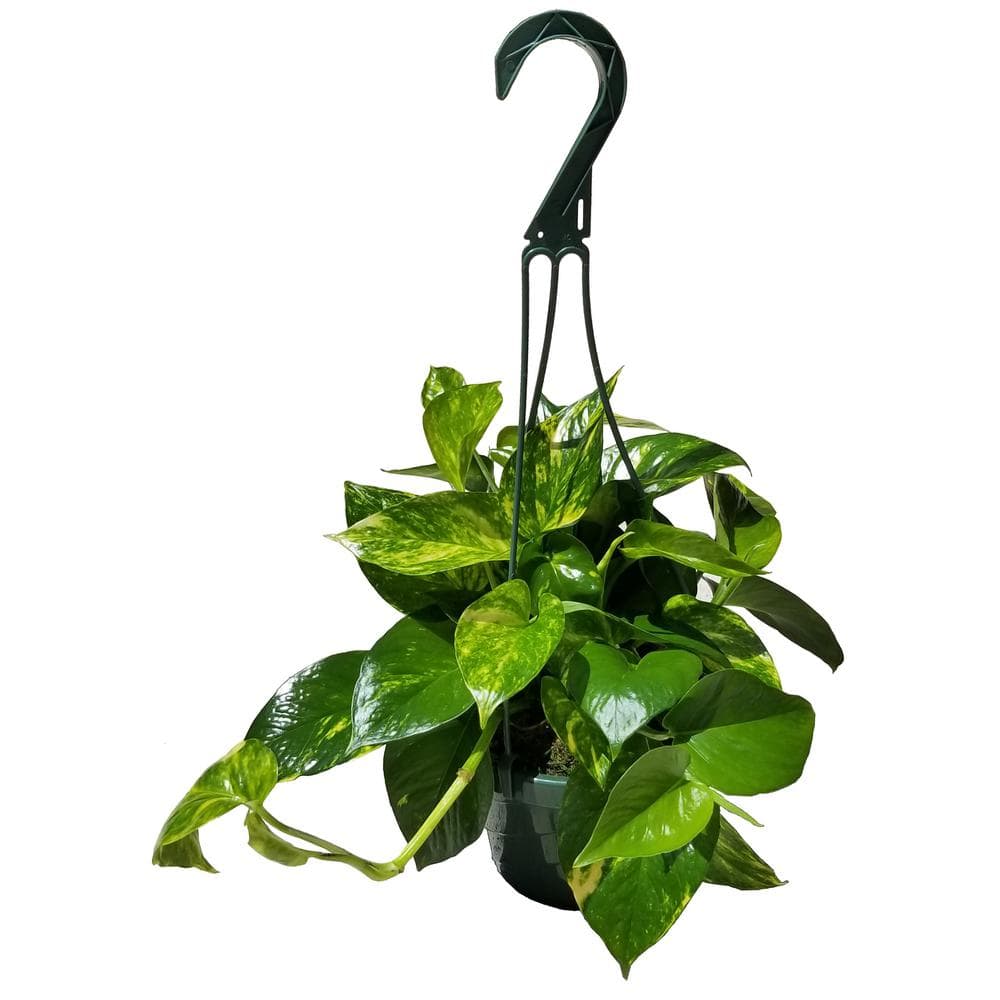
Pothos Plant
Add a touch of romance to a bedroom with a hanging Pothos plant. The heart-shaped leaves grow in long cascading vines. Potted Pothos can look wonderful on top of a high shelf, or potted in a hanging planter, and then placed in front of a window.
Specifications
- Size: When used as a hanging plant indoors, its vines can grow at least three feet long.
- Food/fertilizer needs: Use plant food/fertilizer monthly in the spring and summer. They don’t need to be fertilized in the winter.
- Water: Pothos plants should be watered every one to two weeks. Allow the top soil to dry before watering the plant again.
- Light: Indirect light
- Sun exposure: Not suited to direct sunlight
- USDA hardiness zone: When grown outdoors, they will only do well in USDA zones 10 - 12 (California and Florida).
- Soil condition/pH: Well-drained, slightly acidic soil; pH 6.1 to 6.8
- Price on publish: $16.78 - $18.47
Pros:
- Over 18 varieties
- Can be kept as either a potted or a hanging plant
Cons:
- They have toxic properties and should be kept out of reach of children and pets.
The bottom line:
Both Modern Sprout’s Sarah Burrows and Living With Green’s Byrnes recommend Pothos plants because they’re beautiful, improve air quality, and last for a long time.
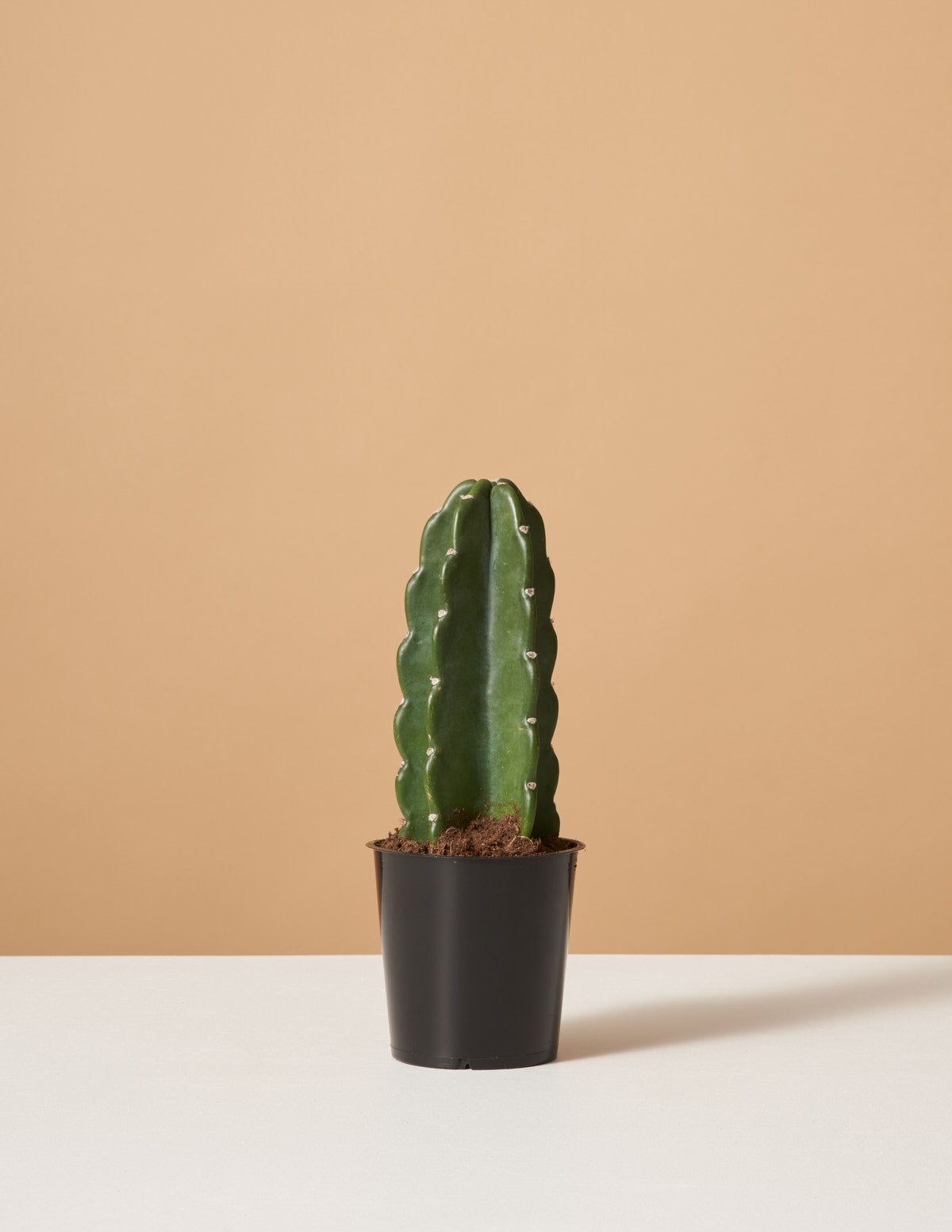
Cuddly Cactus
If you’re rarely at home or travel a lot, cacti are the perfect plants to own. They’re virtually indestructible. Simply stick them in a clay container, plop them before a window, and you’re done.
Specifications
- Size: Can reach one to two feet tall
- Food/fertilizer needs: Feed or fertilize cacti during the spring if you notice new growth. Then, they should be fed every eight weeks during the summer months.
- Water: Cuddly Cactus should be watered every two to three weeks during the warmer months and every four to six weeks during the winter. Let the soil dry completely between waterings. There are two ways to water cacti. The first is bottom watering, where you place the water in the pot’s saucer and let the plant drink it. Be sure to remove excess water. Otherwise, use a water can and drench the soil.
- Light: Bright light to full sun
- Sun exposure: South and west-facing windows; bright light at least four to six hours daily
- USDA hardiness zone: N/A
- Soil condition/pH: Acid-based soil, pH 5 to 6.5
- Price on publish: $19.97 - $68.00
Pros:
- Spineless, so won’t hurt children or pets
- Byrnes says,” There are so many types of cacti, you can build an entire collection on this genus alone.”
Cons:
- You could forget to water them because they don’t need frequent watering
The bottom line:
To add a touch of southwestern flair to your room, add a group of Cuddly Cacti by a window that catches afternoon sun
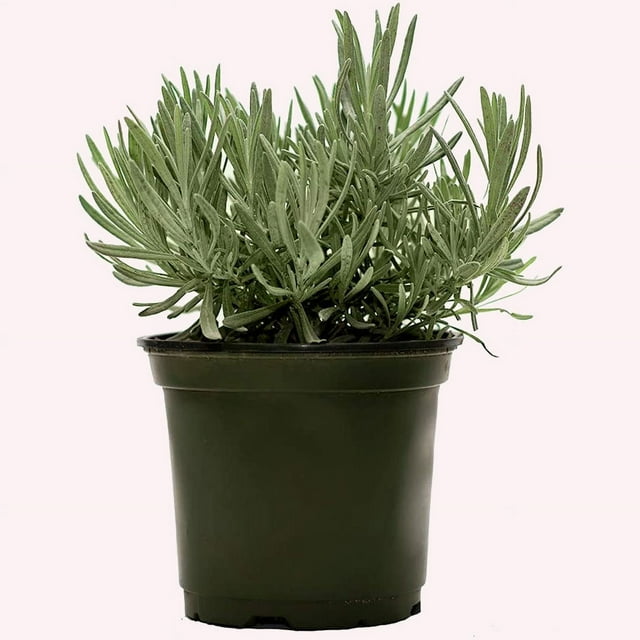
Lavender Plants
Imagine this: the soothing scent of lavender gently perfumes the air of your bedroom, helping you drift off to sleep. One recent study found that the scent of lavender increased sleep quality. This plant, with its purple flowers and silvery green leaves, can aid in turning a bedroom into a calming retreat. Prune it twice a year to keep it healthy and lush.
Specifications
- Size: 14 inches when mature
- Food/fertilizer needs: They should be fertilized every four weeks during the summer
- Water: Lavender plants should be watered every 10 - 14 days. Before watering, check to see if the top soil is wet. If it is, wait until the top soil is dry before watering.
- Light: Full sun for three to four hours
- Sun exposure: They do best in windows that have southern exposure
- USDA hardiness zone: For outdoor plantings, lavender can thrive in zones 6 through 9.
- Soil condition/pH: Slightly alkaline soil, pH 6.7 to 7.3
- Price on publish: $14.99 - $38.98
Pros:
- Soft, gentle scent that is relaxing
- The combination of green, silvery leaves, and purple flowers brightens up any room.
Cons:
- Generally, lavender plants are safe for children and pets unless ingested.
- The plants contain Linalool, which can be toxic to cats and dogs if ingested in large amounts.
- Must be watered daily
The bottom line:
Lavender plants add color and scent to bedrooms, but they should be kept in bright light and on a high shelf away from children and dogs.
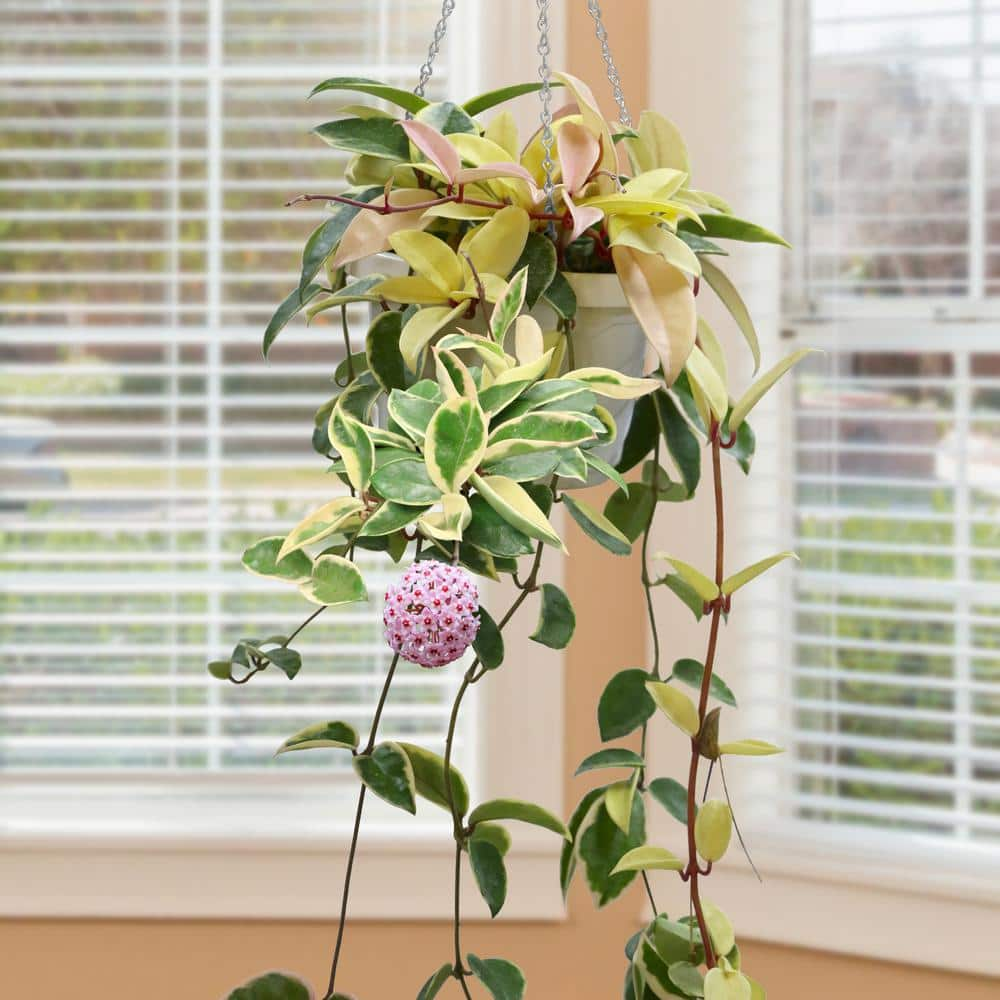
Hoya Carnosa Krimson Queen or Wax Plant
Hoya plants have large, glossy leaves all year long. When they bloom, their flowers look like a cluster of tiny stars. The trick to get them to bloom is to withhold water in the winter and fertilize weekly in the spring. Your bedroom will be awash with gorgeous flowers from late spring to summer.
Specifications
- Size: They can grow up to 12 feet in height
- Food/fertilizer needs: Use plant food once a month
- Water: Hoyas need to be watered once every two weeks. Make sure soil is dry before watering, if the soil is wet, wait until it’s dry to water.
- Light: Non-direct bright light for up to six hours daily
- Sun exposure: South or west-facing windows
- USDA hardiness zone: They can live outside in zones 8 - 11.
- Soil condition/pH: Succulent plant soil, pH 6.1 to 7.5 (slightly acidic or neutral)
- Price on publish: $19.95 - $42.18
Pros:
- Hoya plants come in potted and hanging versions; the genus has solid and variegated leaves.
- All Hoya plants have small star-shaped flowers and are fragrant.
- They are safe for pets and children.
Cons:
- The hanging variety can proliferate with long trailing leaves, making pruning a must.
The bottom line:
Hoyas are a beautiful genus of plants that are safe for children and pets, but they need to be watered daily.
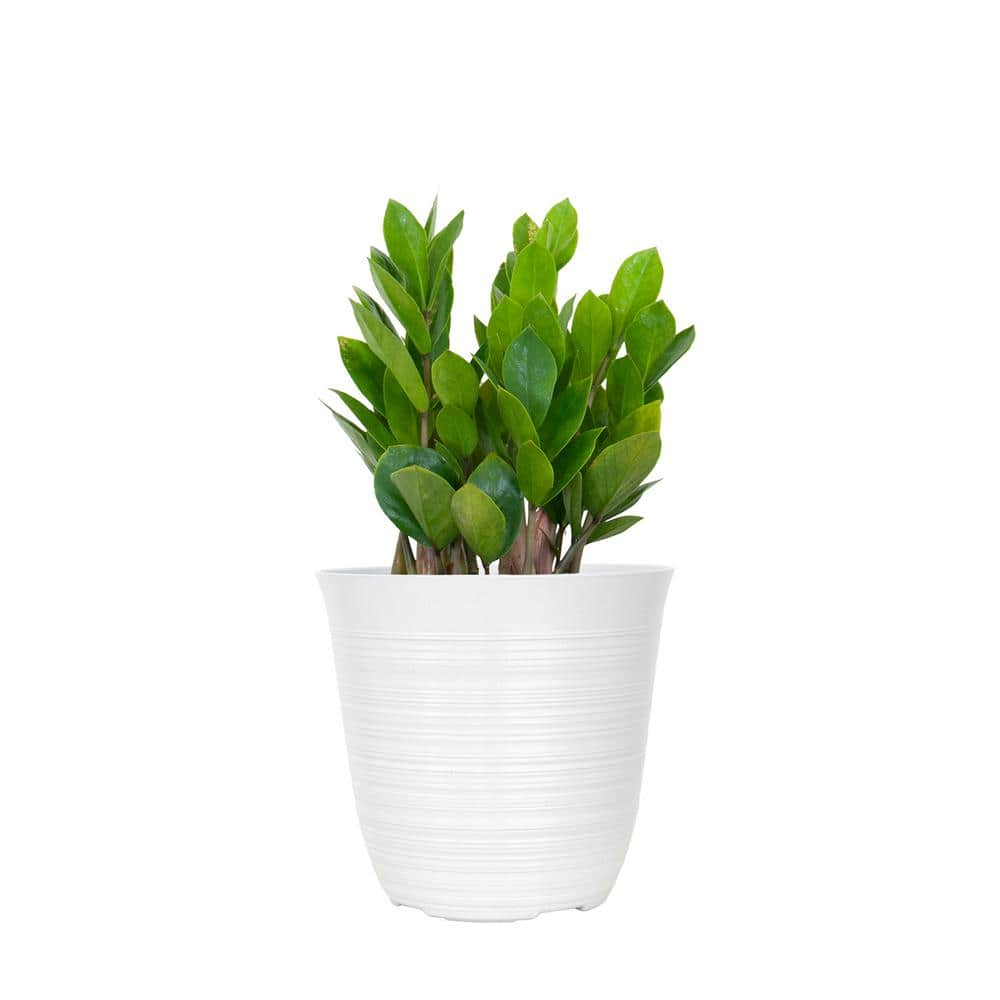
ZZ Plant or the Zanzibar Gem
If you like the idea of a plant, but are concerned about caring for one, the ZZ plant is just what you need. Byrnes mentioned that ZZ plants left in the offices during lockdown thrived without attention for months.
Specifications
- Size: Two to four feet tall, two to four feet wide
- Food/fertilizer needs: You can use all-purpose plant food and feed them every six months
- Water: ZZ plants can be watered every two to three weeks. If the soil is wet, let it dry before watering the plant.
- Light: They don’t need much light, but will grow faster with indirect sunlight
- Sun exposure: Keep away from direct sunlight.
- USDA hardiness zone: They can be planted outdoors in zones 10 -12.
- Soil condition/pH: Slightly dry soil, pH 6.0 to 7.0
- Price on publish: $24.22 - $28.42
Pros:
- ZZ plants are indestructible; they can be ignored for months, and they’ll still flourish.
Cons:
- Their sap can cause skin irritations. When handling the plant, it’s best to wear gloves.
- Must be kept away from pets and children.
The bottom line:
If you’re looking for a lush, green plant that you can place and forget about, the ZZ plant is it.
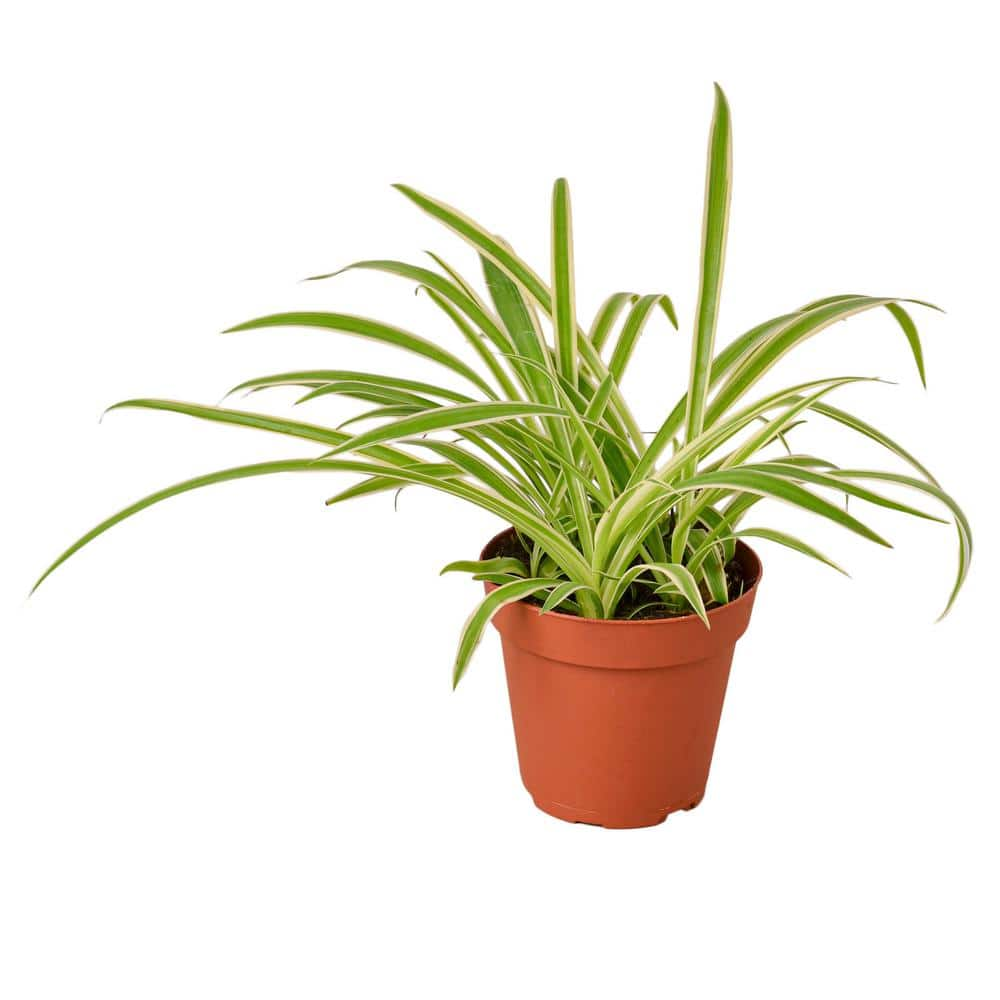
Spider Plant
Spider plants are some of the most common houseplants for two reasons. They look lush with their tricolor leaves that dip and turn. Secondly, they’re an easy-care plant. Just water them once a week, keep them out of direct sunlight, and they’ll last for years.
Specifications
- Size: They can grow up to 24 inches high and up to 36 inches wide
- Food/fertilizer needs: Spider plants must be fed once to twice a month from spring to autumn
- Water: They should be watered once a week, or when the topsoil is dry to the touch.
- Light: Bright, indirect light
- Sun exposure: Place it near an east or west exposure
- USDA hardiness zone: Zones 9 - 11
- Soil condition/pH: Nutrient-rich, slightly sandy soil; pH 6.0 to 7.5
- Price on publish: $15.99 - $19.99
Pros:
- Easy to grow, and will occasionally throw small white flowers
- Can be grown potted or as a hanging plant
- They can miss the occasional watering
- Safe for four-footed friends and children
Cons:
- Though not toxic, they’re a minor hallucinogenic to cats and can cause digestive upset
- All spider plant varieties grow quickly, so they may need to be pruned.
The bottom line:
Non-toxic Spider plants can be potted or placed in a hanging planter.

Chinese Money Plant AKA Coin Plant AKA UFO Plant
73% offSave $35
The Chinese Money plant is also known as the UFO plant and the pancake plant due to its round leaves. It doesn’t need a lot of water to survive, but it grows quickly and has baby plants, so you can share the offshoots with friends.
Specifications
- Size: 12 inches tall
- Food/fertilizer needs: Fertilize plant every month in the spring and summer
- Water: They should be watered when the soil is between 50% to 75% dry, or every two weeks.
- Light: Medium to bright indirect light
- Sun exposure: Can be placed in any exposure, but not in direct sunlight
- USDA hardiness zone: Zone 10, but best indoors
- Soil condition/pH: Peat-based soil, pH 6.0 to 7.0
- Price on publish: $11.99 - $16.50
Pros:
- The round green leaves look like coins, hence its name.
- It’s related to the Pothos and Jade plants.
- It only needs to be watered once a week
- Safe for pets and children
Cons:
- While it likes bright sunlight, it can’t handle direct light.
- Finding a semi-shady spot may be hard to find in some bedrooms.
The bottom line:
This perennial is a once-a-week waterer that only needs food during the summer, and it’s non-toxic to pets and children.

Phalaenopsis Orchid
A lot of people think that orchids need to be babied, but they’re a hardy plant. If you treat them well, they’ll bloom for years and years. They come in a variety of colors and types. Not only are they pretty, they’re great for your health and easy to find.
Specifications
- Size: Six inches to three feet high
- Food/fertilizer needs: Feed every one to two weeks during the growing season, every three to four weeks while blooming, and every three to four weeks in winter. Use orchid plant food and follow bottle directions for proper dilution.
- Water: Orchids should be watered once a week in the winter and twice a week during the warmer months. First, mist the moss in the planter (if it has any), and then water the roots until the water runs out of the pot. Wait 10 - 15 minutes, and then water the plant again. After watering, remove any water that is in the pot’s saucer. Orchids should only be watered when the substrate is completely dry.
- Light: Bright light, but not direct sunlight (so no window sills)
- Sun exposure: Avoid hot exposures, keep away from east and south-facing windows
- USDA hardiness zone: Can live outdoors in Zones 10 - 12.
- Soil condition/pH: Sphagnum moss or bark substrate. The pH needs to be between 5.0 and 6.0.
- Price on publish: $35.69 - $74.00
Pros:
- Come in many colors
- Can last for years
- Easily found in some grocery stores
- While they look exotic and delicate, they require low maintenance
- Safe for pets and children
Cons:
- Needs to be misted daily, especially in the winter
The bottom line:
Gorgeous to look at, this plant is safe to keep around children and pets.

Friendship Plant
The friendship plant has spectacular-looking leaves.Tricolor, with touches of bronze, brown, red, green, and silver, they look like a living art piece. In nature, they’re found on forest floors, so give them lots of indirect sunlight at home.
Specifications
- Size: 12 inches
- Food/fertilizer needs: Fertilizer should be at half strength and fed once a month during spring and summer
- Water: Generally speaking, Friendship plants should be watered once a week. However, If the plant is kept in low light, it should be watered less than that. The basic rule of thumb here is to water it when the soil feels dry.
- Light: Low to medium light
- Sun exposure: Indirect sunlight
- USDA hardiness zone: If keeping it outdoors, the plant will do well in sunny climes like zones 11a to 12b (Southeastern part of the US, Hawaii, and Puerto Rico)
- Soil condition/pH: Slightly moist soil that has a well-drained pot; pH of 6.0 to 7.0
- Price on publish: $6.99 - $28.07
Pros:
- Soft fuzzy green leaves with touches of bronze and silver are visually arresting
- Safe for pets and children
- Can be placed in a terrarium or grouped with other small plants on a shelf or table
Cons:
- Grows horizontally, so you may have to trim the leaves often
The bottom line:
The low-maintenance Friendship plant has strikingly colored leaves and is safe for kiddos and four-footed friends.
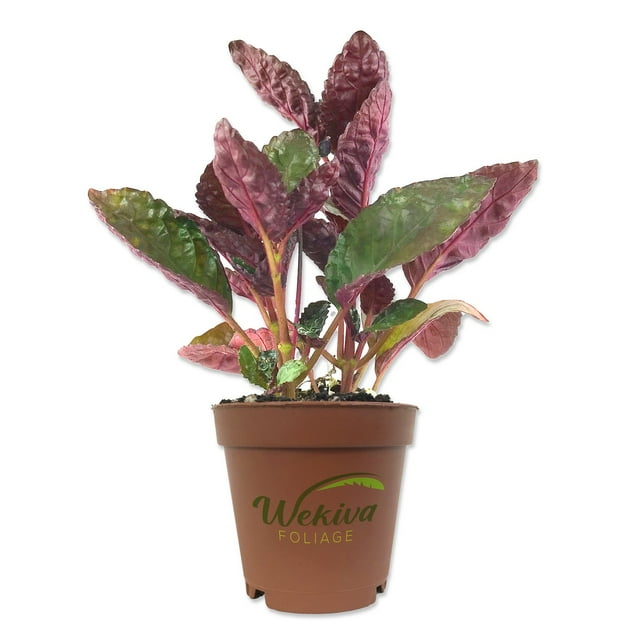
Purple Waffle Plant
The Purple Waffle plant’s leaves can range from deep purple to a mix of silvery green and light purple. No matter what color leaves, the plant shows off its white flowers in summer. It’s a low-maintenance plant that likes indirect sunlight.
Specifications
- Size: 6 inches tall
- Food/fertilizer needs: During the spring and summer months, fertilizer should be at half strength
- Water: Water the Purple Waffle plant at least once a week; this plant likes its soil moist.
- Light: Bright, indirect light
- Sun exposure: Avoid direct sunlight
- USDA hardiness zone: If using the Purple Waffle Plant as an outdoor groundcover, plant it outside in zones 10 - 11
- Soil condition/pH: Soil should be rich and moist; pH range of 5.0 to 7.0
- Price on publish: $18.53 - $28.71
Pros:
- The purple waffle plant can release moisture to the air, and using photosynthesis, ingest carbon dioxide and then release oxygen into the air.
- During the summer, it blooms tiny white flowers
Cons:
- Needs to be misted daily, especially in the winter
The bottom line:
Gorgeous to look at, this plant is safe to keep around children and pets.

Bamboo Palm
The Bamboo Palm is a tropical plant that loves indoor life. It has feathery leaves, doesn’t like being overwatered, and enjoys medium sunlight. They can grow up to 12 feet tall. Place it in the corner of a bedroom to add visual interest to the room.
Specifications
- Size: Reaches 4 to 12 feet depending on conditions
- Food/fertilizer needs: Once a month during the growing season (spring and summer)
- Water: The bamboo palm plant is thirsty and likes to be watered up to three times a week when it’s warm out. Cut back on watering it every two to three weeks during the fall and winter months.
- Light: Low light to bright indirect light
- Sun exposure: Morning sun; avoid afternoon sun
- USDA hardiness zone: Zones 10 - 11 if you want to re-plant it outdoors
- Soil condition/pH: Rich, moist soil that has a well-drained pot, soil should be slightly acidic with a pH between 5.0 to 7.5.
- Price on publish: $67.78 - $162.71
Pros:
- Stems and leaves aren’t toxic to pets and kids
Cons:
- It doesn’t like cold or wet weather
- Best for larger-sized bedrooms
- Berries are toxic to pets and people
The bottom line:
This is a hardy, long-lasting indoor plant that provides long-term health benefits and is not toxic.

Miniature African Violets
You can always have more than one. Miniature African violets have flowers that range in form, including white, orchid, lavender-pink, pink, violet, and every shade in between. Because they’re small plants, you can create an arrangement of three or four plants. The complementary colors of the flowers can brighten up a table or dresser top.
Specifications
- Size: Three to six inches wide and up to six inches tall
- Food/fertilizer needs: Once a week using African Violet food. Start with half-strength because it’s easy to over-fertilize. Don’t fertilize for a few months if the plant was just repotted.
- Water: African Violets soil should be almost completely dry before watering them. The bottom water method is the best (and easiest) to water them. Place water in the pot’s saucer, and let the plant drink in the water. Remove any standing water from the saucer to prevent root rot.
- Light: Bright light; requires 10 hours of light a day to bloom
- Sun exposure: Southern exposure
- USDA hardiness zone: Zones 11 - 12, but are primarily a house plant
- Soil condition/pH: Soil should be moist, and can be a mix of regular potting soil and African Violet potting soil with a pH level between 5.5 and 6.5.
- Price on publish: $19.99 - $34
Pros:
- Can bloom throughout the year and the flowers come in various colors
- Only needs to be watered once a week
Cons:
- Requires constant temperature between 60° to 80° Fahrenheit and 50 - 80% humidity
- Not toxic if eaten but pets can develop digestive upset
The bottom line:
Because they are small, adding a few non-toxic, colorful Miniature African Violets to your space can create a visual delight to wake up to every morning.
Best value pillow for neck pain: Boston Fern
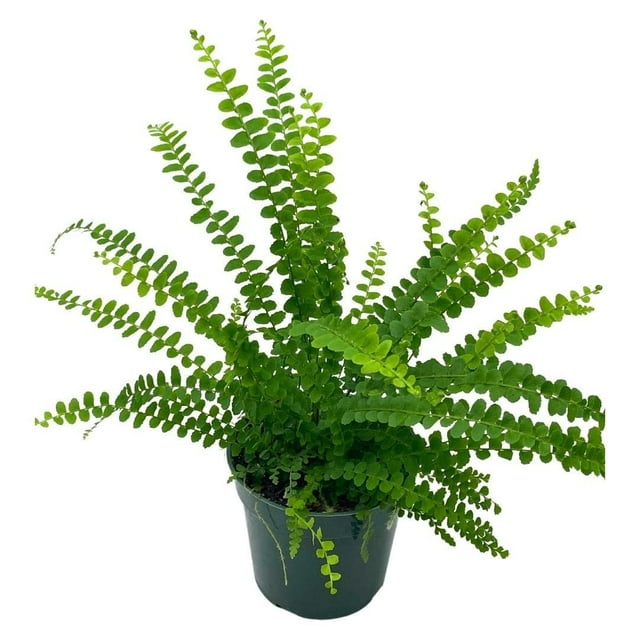
Boston Fern
Boston Ferns have long, elegant leaves that flutter in the breeze. Their light green leaves look especially sophisticated when potted in a tall planter. Boston ferns grow horizontally, not vertically, which makes them excellent candidates for hanging planters.
Specifications
- Size: Up to two feet high and three feet wide
- Food/fertilizer needs: Every 4 - 6 weeks when actively growing; do not fertilize in the winter
- Water: Boston ferns love water, so water them twice a week, and mist them on the days you don’t water them.
- Light: Bright indirect light
- Sun exposure: They do best in the morning light; avoid southern exposure windows
- USDA hardiness zone: If placed outdoors, Boston Ferns can live in zones 8B - 11. They are best kept as indoor plants.
- Soil condition/pH: Needs rich soil with a lot of nutrients with a pH of 5.0 to 5.5.
- Price on publish: $21.99 - $22.99
Pros:
- Can be used as a hanging or potted plant
- Easy care
- Safe for pets
Cons:
- While the soil needs to be moist, it’s easy to over water them.
- Grows quickly and needs to be trimmed
The bottom line:
Boston Ferns are lush plants that thrive all year long whether they’re used as a hanging plant or kept potted.
What to consider when buying plants for the bedroom
There are many different types of indoor plants, so choosing the best one for your bedroom can be difficult. Do you want a flowering plant? Do you need indoor plants for low light areas? Can office plants thrive in a bedroom? Are cacti a good bedroom plant?
I chatted with gardening and plant experts on how to pick the best plants for the bedroom. Before choosing a plant, Blaine Tiongson of California-based Momma Pots says, “There are several factors to consider ensuring they (plants) thrive and to avoid any plant nightmares.” Light, space, sensitivity/toxicity, humidity, and fragrance are the elements you need to assess before purchasing any plant. Tiongson’s store showcases not only plants but also her custom-designed planters.
Light
How much natural light your bedroom receives during the day will influence what type of plant you buy. The size and number of windows determine the natural light in your bedroom. If you have one large window or more than one window, chances are your bedroom doesn’t need artificial light (lamp or ceiling fixture) during the day.
Kyle Kroeplin, co-founder and head grower at the Orlando-based BWH Plant Co., recommends Sansevieria (Snake Plants) and Aglaonema (Chinese Evergreen) for bedrooms with low light and regular humidity. He also suggests Alocasia (Elephant Ears) and Hoya (Wax Plants) for bedrooms with bright natural light and higher humidity. If you don’t have a lot of light in your bedroom, you can still place plants there. Kaylyn Hewitt, says, “Some of my favorite houseplants do not require tons of light, so no need to shy away from plants if you don’t have a room full of windows.”
Another element to consider before buying a plant for your bedroom is what type of natural light shines through your window. Does your bedroom get morning or afternoon light? Certain plants like Geraniums love bright afternoon light, while Boston Ferns enjoy the rays of soft morning light.
Lastly, find out if your home has southern or northern exposure. A south-facing house or apartment will get the most sunlight during the day. A house that has northern exposure will get less sunlight during the day. Using a compass is the easiest way to find out what type of exposure you have. Knowing what kind of exposure you have will help determine the best plants that will blossom outside (and in) if you're also planning on landscaping or gardening. “Always place your plant in the room according to its light requirements,” explains Kroeplin.”You can always move it if it’s not loving the first spot.”
Space
Before you buy plants for your bedroom, consider the size of your space. Small bedrooms often benefit from having one to three small plants, whereas oversized bedrooms could look good with either many small plants or one or two large plants. Place them in safe spots like a shelf with enough room for the pot and the leaves so the plants don’t topple over from lack of space.
Sensitivity/toxicity
When choosing plants, Tiongson suggests considering any pollen or plant oil allergies. She says,” If you have pets or small children, be cautious about selecting toxic plants if ingested.” She suggests staying away from Philodendrons, as they are poisonous if ingested. Other indoor plants that can be toxic to pets are Lilies, Aloe Vera, Dieffenbachia, Sago Palm, Pothos, and the Peace Lily (which, despite the name, isn’t a true lily). It’s best to consult your veterinarian and pediatrician to ensure the plants are not dangerous.
Humidity
“Air conditioning and heat can create a dry environment that would not be great for ferns or orchids,” says Tiongson. Does your bedroom run hot or cold? Do you live in the sub-tropics, or where it’s always cold? The USDA Plant Hardiness Zone Map, created in the 1960s by the U.S. Department of Agriculture, is primarily a tool for planting outdoors. It can also give you insight into what plants will thrive indoors. The zones divide the country from the coldest (Alaska) to the warmest zones (Puerto Rico, Hawaii). The zones are used to determine a plant’s hardiness in specific environments. For example, the Peace Lily can be grown outdoors in hardiness zones 10 - 12 (Hawaii and Puerto Rico). If grown indoors, they can thrive in any climate.
“Always consider environmental factors like air conditioning and temperature when choosing plants,” adds Kroeplin. If you like to keep your home cool or warm all year round, look for plants that enjoy those temperatures.
Fragrance
Some indoor plants have fragrant blooms. You could place jasmine, lavender, and tea rose begonias in a bedroom to create a unique, relaxing aroma that helps lull you to sleep. However, some people do not like, or are sensitive to, scents, and you can find non-fragrant plants like ficus, pothos, or jade plants to place in your bedroom. ## How to water and maintain bedroom plants
Plants arrive with care instructions, including when to water them. Hewitt suggests, "Once a week is a good rhythm to start, and you can determine your needs after the first week. Be sure to pay attention to the soil when watering plants.” Hewitt adds, “Warning signs often show up in the soil first, like watering already drenched soil, so you can avoid mistakes by monitoring your soil.”
When to water your plants
The time of day you water your plants can affect their health. “Watering during peak daylight hours could potentially scorch the leaves,” states Tiongson.” This can result in irreversible damage.” If a plant is too warm, she advises to “place the pot in a larger container filled with water, allowing it to soak up water through the bottom drainage hole. This will revitalize the soil, enabling normal watering practices in the future.”
Burrows suggests that you may need to water your plant more during the hotter months. The plant may need more water if the soil feels dry and the leaves are drooping. She suggests touching the soil one inch below the surface; the plant doesn’t need water if it feels damp.
Plant maintenance
An easy way to maintain your plant’s health is to dust it. Hewitt says, “Dusting often gets overlooked in plant care. But it does so much for your plants. Plants breathe through their leaves, so don’t let the dust get in the way of that.”
Proper pot drainage ensures a plant’s health and helps maintain it. If a pot doesn’t have a drainage hole, Burrows suggests using a smaller plant with a drainage hole, then placing it inside a larger pot and filling the excess space with dirt to conceal the interior. Hewitt offers another option: if you’ve decided on a pot without a drainage hole, you can create a drainage system by filling the bottom with rocks and charcoal.
To keep a plant healthy, learn when and how to prune, deadhead, and repot each specific plant you own. Each specific plant has its own schedule.
Troubleshooting tips
Overwatering
Many first-time plant owners are so concerned about their plants drying out that they end up overwatering them instead. Kroeplin states, “Signs of overwatering include yellowing leaves, wilting leaves, and a constantly soggy soil. To tackle this, tweak your watering routine by letting the soil dry.” He suggests that if that doesn’t help, “Think about repotting into well-draining soil, removing any mushy brown roots in the process, and always use pots with drainage holes to avoid waterlogged conditions.”
Brown leaves
Brown leaves can signal underwatering, excessive heat, or dryness. Burrows suggests placing a humidifier near the plant and assessing the soil’s moisture to see if it’s too dry.
Pests
Inspect your plants to ensure that aphids aren’t present. If one plant has them, quarantine that plant and take care to get rid of them. All my experts agree that Neem oil is a safe, organic method to rid any plant of insects and pests.
Wrong pot size
A pot that is too small or too large can cause trouble for plants. Signs that a pot is too small are the plant looks stunted, the soil dries out quickly, or you see roots growing out from the drainage hole at the bottom. Repot the plant in a larger container but if you’re not sure what size is right, consult your local plant shop. It’s easy to go too big with some plants, like cacti.
If a pot is too big for the plant, leaves may turn yellow while the soil stays wet or is always wet. Keeping a plant in an oversized pot can also lead to root rot and other issues. Find an appropriate sized smaller container and repot your plant.
How we selected the best plants for bedrooms
Expert advice
I selected the best plants for bedrooms with the help and assistance of the many experts mentioned in this article. All of my experts are prolific gardeners. They run nurseries, both online and in real life. They all turned their love of everything green into a career.
Easy maintenance
When choosing the best plants for a bedroom, I specifically chose plants that work well for beginning and advanced plant lovers. That meant any plant chosen for this piece would be easy to take care of on a weekly basis.
Pet and family safe
The last thing you want to bring into your home is a plant that can harm your family. That’s why the majority of pants chosen for this piece are pet- and kiddo-friendly. A few plants on this list aren’t good for pets, and they are labeled as such.
Easy to find
Just as I opted to pick easy-care plants for this roundup, I selected plants that you can find anywhere. That means, you’ll see them in the nursery section of big box retailers, your local grocers, online, and at plant stores.
Frequently asked questions (FAQs)
Is it good to sleep with plants in your bedroom?
Not only do plants provide oxygen, but they also provide comfort, so sleeping with plants in your bedroom may benefit some people.
There have been studies that indicate plants enhance the quality of sleep and mental and physical health. In addition to its lovely fragrance, a very recent study found that lavender aided in acquiring a better night’s sleep as well as better sleep quality, and were more alert during the day.
Which plant is best for a bedroom for oxygen?
Since every plant takes in carbon dioxide and releases oxygen, there is no one plant that is best. Find plants that you enjoy having in your bedroom and incorporate them into your space.
What is the best plant for bedroom air quality?
Many plants improve air quality via photosynthesis, the taking in carbon dioxide and releasing oxygen; some plants do it a tad better than others. They are Spider plants, Snake plants, ZZ plants, Pothos, and the Boston Fern. Scientists are now looking into other ways plants can help improve air quality. Two recent studies, one in 2020, and one in 2022, indicate that plants might be able to remove airborne toxins via phytoremediation. Nothing definitive has been found yet, as the investigation is continuing.
How many plants should I have in my bedroom?
All the experts were asked this question and agreed that the amount of plants in a bedroom is at the owner's discretion.
Where is the best place to put plants in the bedroom?
You can place a small grouping of plants on a dresser or a nightstand. A hanging plant could be placed in front of a window; just check what is the best light for a hanging plant. A larger-sized bedroom could hold a tallish bamboo plant. If there’s a bookcase in the bedroom, one or two shelves could hold plants. If choosing plants that might be toxic to dogs or children, it’s best to place them up high on a shelf where they can’t be reached.
Which plants are suitable for bedrooms?
Plants that love low-level and indirect sunlight are perfect for bedrooms, as most have less natural light. Some good options include Snake, Pothos, Spider, and ZZ plants.
Will plants in the bedroom attract insects?
Indoor plants may sometimes attract bugs, but if you keep them healthy and regularly check them for insects, you can quickly prevent or stop an infestation. You can add plants like basil, lemongrass, peppermint, or citronella—which repel insects—into your mix of bedroom plants. If you do find a plant with aphids or other bugs, remove it from the room and treat it. After the pests are gone, you can bring it back into the bedroom.
How often should I water my bedroom plants?
How often you need to water your plants depends upon their needs. ZZ plants can be ignored for months, while African Violets need to be watered once a week. Check your soil to see if it’s dry or moist; if the soil is dry, plants should be watered. When purchasing plants, keep their care information in a digital or paper folder for easy reference.
What is the best way to remember to feed and water plants in the bedroom?
An easy way to remember when to feed and water the plants in your bedroom is to set a reminder on your phone and/or calendar. You’ll automatically get alerts when they need to be taken care of.
Do bedroom plants need fertilizer?
All indoor or outdoor plants need plant food, AKA fertilizer. They usually need to be fertilized during the growing season, which is the spring and summer months. Refer to your plant care guide and the fertilizer instructions on how and when to fertilize your plants. Some plants need the fertilizer to be diluted at specific times of the year.
Do bedroom plants need sunlight?
All plants need sunlight to survive. However, some plants thrive in low-light or indirect light.
Can plants in the bedroom reduce stress?
Plants in a bedroom can reduce stress and increase a sense of relaxation. A recent study cited that plants can provide comfort and ease when placed in a room.
Are there any plants that are toxic to pets and should be avoided in the bedroom?
Plants like Lilies, Pothos, ZZ, and Philodendrons can be toxic to pets. Before purchasing any plant, consult with your veterinarian or check the ASPCA’s list of plants that are toxic to cats and dogs.
Can I keep flowering plants in a bedroom?
African Violets and orchids are the most common flowering bedroom plants. Make sure that they receive the type of light they need to thrive. If there isn’t enough natural light for your plant to bloom, look into getting a plant light.
What do I feed my plant?
Most plants do well with a basic plant food mix. Some plants, like orchids, African Violets, and cacti/succulents, need special plant food.
What is the best potting soil?
Most plants will do well with the basic potting soil in supermarkets and garden stores. Some plants require a specific type of soil or substrate that can be found online and in nurseries.



















